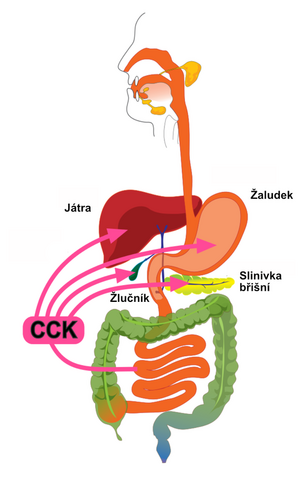Cholecystokinin
| epithelial cells of the upper part of the duodenum | |
| polypeptide of 58, 33, 22 or 8 AMK | |
| cholecystokinin receptor B coupled to a G protein | |
| mainly stimulation of pancreatic juices, increase in intestinal motility, more in the article | |
| 118440 |
Cholecystokinin-pancreozymin (CCK) is secreted by the epithelial cells of the mucosa of the upper part of the Duodenum. It is also found in the brain, where it appears to be involved in controlling food intake. CCK is secreted by contact of the intestinal mucosa with digestion products, mainly peptides, AMK and fatty acids. There is also a positive feedback loop, when under the influence of CCK Bile and Pancreatic Juice, are secreted , which increase the digestion of proteins and fats, the products of which then stimulate the secretion of CCK.
CCK induces contractions of the gallbladder and relaxation of the sphincter of Odi, stimulating the secretion of enzyme-rich pancreatic juice. It inhibits gastric emptying, has a trophic effect on the pancreas, increases the secretion of enterokinase, can increase the motility of the small intestine and colon, stimulates the secretion of glucagon, temporarily increases the intracellular concentration of calcium.
Links[edit | edit source]
Related Articles[edit | edit source]
References[edit | edit source]
- Kittnar, Otomar, et al. Medical Physiology. 1st edition. Prague: Grada, 2011. 790 pp. ISBN 978-80-247-3068-4
- GANONG, William. Review of Medical Physiology. - issue. Galén, 2005. 890 pp. pp. 491. ISBN 9788072623112

